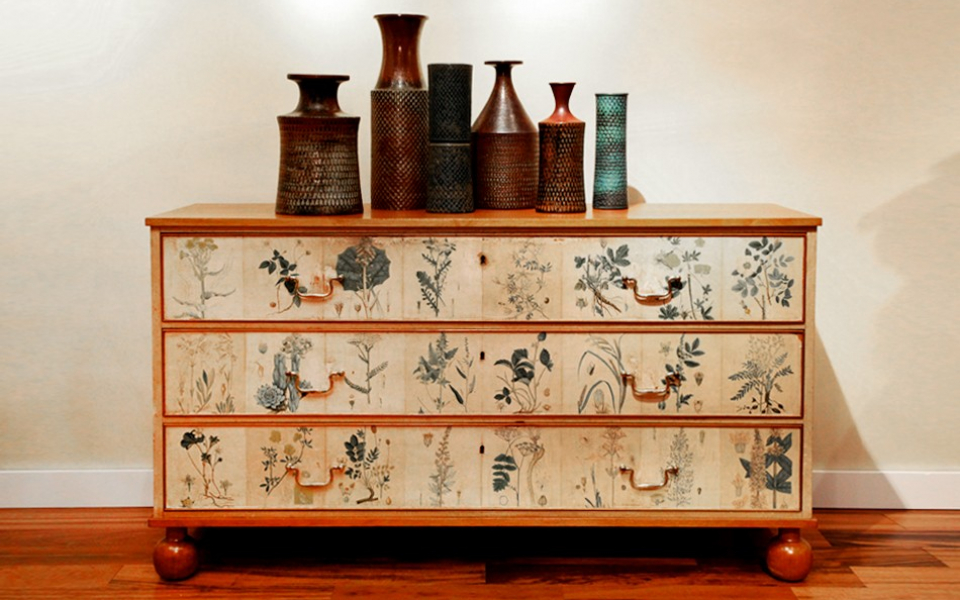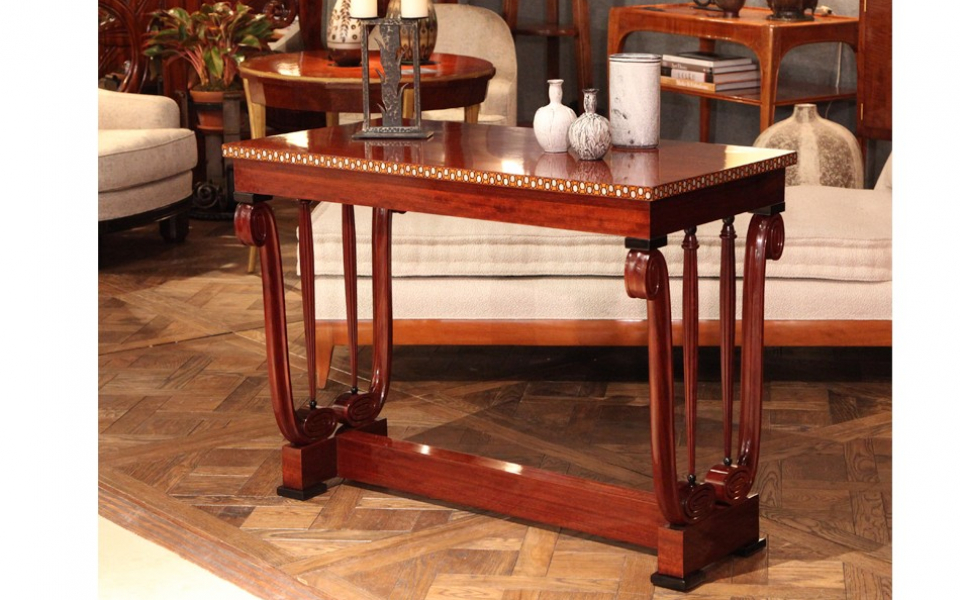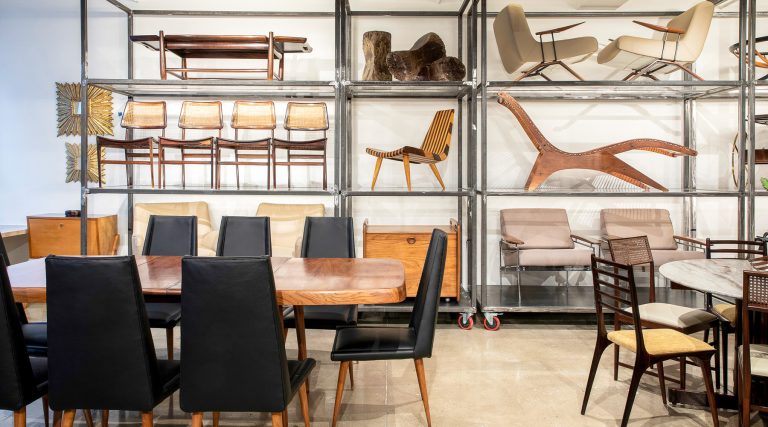February 9, 2015The 61st Winter Antiques Show (WAS), a 10-day extravaganza at New York’s Park Avenue Armory which closed February 1, is the apotheosis of antiques shows — a high-end assortment of international purveyors of fine art, furnishings and decorative objects, 24 of whose exhibitors are represented year-round on 1stdibs.
As antiques professionals know, the finest pieces are not necessarily the first to fly out of a gallery — or an antiques show. An extraordinary object may have to wait for an extraordinary buyer. Hirschl & Adler Galleries, a WAS stalwart, had to wait 20 years to sell a gilded-wood eagle sitting atop a gold sphere that was carved in 1811 by neoclassical sculptor William Rush for St. John’s Lutheran church in Philadelphia. At long last, the Metropolitan Museum of Art picked it up and gave it pride of place when it reopened its American Wing in 2012, says Elizabeth Feld, the gallery’s managing director and chairman of the fair’s dealers committee. “Great works aren’t made any less great because they don’t sell right away.”
Bearing this in mind, we canvassed the Winter Antiques Show closing weekend, asking 1stdibs gallerists to each shine a spotlight on one very special piece from the fair that is still awaiting a discerning buyer. Here’s what they had to say about their selections, all now found — discerning buyers take note! — among the treasures on 1stdibs.

A La Vieille Russie Classical revival styles were the rage in Europe when this 18K-gold fringe necklace, above left, was made around 1890, says A La Vieille Russie's Mark Schaffer, seen at right in his WAS booth. Its palmettes, alternating with floral motifs, typify Etruscan Revival. “You know it’s French by the weightiness and crispness of it,” he says, as well as the reddish-gold tone of the piece and the finely detailed wirework. It’s attributed to Eugene Fontenay and was sold by Paris jeweler Paul Harmelin. Says Schaffer, “I’ve never seen another like it.”

Adelson Galleries “If you want to know who Andrew Wyeth is, here it is,” the American realist painter himself once said, referring to his own images of his historic mill home in Chadds Ford, Pennsylvania. This wintry scene — the watercolor Frozen Race, which depicts a sunlit corner of a building as well as Wyeth’s golden Lab, Nell — was painted in 1969, a time when Wyeth “was producing some of his best works on paper,” says Warren Adelson. “The sixties showed a shift in his style where he became more crisp, and his light became more focused, and this picture is exemplary of that.” Image © Andrew Wyeth

Associated Artists Artifacts of the Gilded Age don’t get any more evocative, or have a provenance more impressive, than a pair of rare Herter Brothers side chairs (one of which is seen at left), which were made around 1880 for J. Pierpont Morgan’s Pompeii-themed Madison Avenue drawing room. “These were couture chairs, created for the room,” says Associated Artists' Katelyn Remington of these gilded maple chairs with goat-hoof feet. (Other gallery offerings at the fair are visible at right.) The elaborately decorated seats and backs were custom-painted to match the room's gold-flecked walls and embroidered to match its Pompeian-red pilasters. There are five known chairs from the set; one is in the Met.

Barbara Israel Garden Antiques Many centuries ago, a young boy got a thorn in his foot and leaned over to remove it. The moment was captured in a 1st-century bronze statue now in Rome’s Capitoline Museum, and again almost two millennia later, circa 1880, by the J. L. Mott Ironworks of New York, a maker of decorative sculptures and garden ornaments. That zinc statue, Lo Spinario, left, which has been stripped and re-patinated, “appeals across the board, especially to little kids,” says dealer Barbara Israel, in her WAS booth, right. What she finds most extraordinary about it is the fact that “somebody created this very human situation so long ago.”

Carlton Hobbs The only piece of furniture renowned English sculptor Henry Moore ever made is this circular marble table on a flared hyperboloid base. A marvel of stability and structural economy, the table was made by Moore for his family’s vacation home in Forte di Marmi, Italy, during a long summer vacation in 1963. The material — the same marble, Moore was fond of pointing out, used to build ancient Rome — came from the nearby quarry that Moore selected for a prior sculpture commission for UNESCO in Paris. "It’s an absolute one-off," says the gallery's Stefanie Rinza. “There’s no other.”

Cove Landing During 30 years in the business, Angus Wilkie of Cove Landing had come across only one other piece of pottery of this type — ceramic pitchers, tankards and blackjacks from Royal Doulton, the 200-year-old English tableware company, exquisitely crafted to mimic stitched, nail-studded leather vessels. Recently Wilkie acquired a collection of 32 such pieces. A product of the Arts and Crafts era, dated 1890-1910, “they even have marks and indentations to make them look like they’ve been knocked around the tavern a bit,” he explains. The uncommon wares confound even the most experienced collectors. Says Wilkie: “A lot of dealers have never seen them.”

Hirschl & Adler Galleries “Everyone gravitates toward this piece,” says Kate Heckard of Hirschl & Adler, referring to a lustrous circa-1880 mahogany and fruitwood tiered square table with a Japonesque feel, made by A.& H. Lejambre of Philadelphia, left. “It has all the qualities of the Aesthetic taste,” she says — simple form but intricate detail, including brass straps and sabots and a most charming inlaid spider web on top. (Another view of the gallery's WAS booth, right.) The Met owns a similar table by the same makers, but none of the handful of Lejambre tables that have come to light are identical. “It’s so, so rare.”
_

Hostler Burrows “The first time I saw this piece was twenty-five years ago, and I was a hardcore modernist,” says Kim Hostler of the circa-1940 decoupaged Flora chest that was a collaboration between Austrian-born designer Josef Frank and Estrid Ericson, director of the Swedish design firm Svensk Tenn. “But I fell in love with it, and that’s when I embraced a softer modernism.” Made of mahogany with ball feet, its front is decorated with applied 19th-century botanical prints. “The scale of the chest is so Viennese, but the use of the hand-colored floral papers, which are works of art on their own, is very northern European," Hostler says. "In those long cold winters, this sunny yellow chest is delightful to look at.”

Hyde Park Antiques, Ltd “This was a statement piece,” says Daniel Bruce of Hyde Park Antiques, Ltd., of a circa-1710 Queen Anne double-dome bookcase, left. (More galleries offerings at the fair are seen at right.) “The rarity and expense of materials were an indication of social status.” Made of French walnut, it would have had a prominent place in the reception room of a grand house in England. The architectural piece has three parts — a chest of drawers below, a secretary desk in the middle, and a bookcase above — plus bells and whistles galore, including gilt flaming-urn finials over etched-mirror doors, a mirrored niche flanked by fluted Corinthian columns incorporating pigeon holes and two secret compartments.

James Robinson, Inc. Two hundred years ago, “when people traveled, they would leave locks of their hair for their loved ones to carry,” says Joan Boening, president of James Robinson, Inc., the antiques business her grandfather founded in 1912. This delicate 20.5K-gold-and-enamel two-sided locket, decorated with birds and butterflies, was made in Paris around 1815 for that very purpose. Its creator, Gabriel-Raoul Morel, was famed for his gold-and-enamel boxes. “It’s the epitome of good enamel work,” says Boening, “remarkable for its time and in extraordinary condition.”

Kentshire From the set of the 1946 movie Humoresque comes this 14K-gold-and-diamond bangle bracelet with scroll motifs and a monumental rectangular amethyst, offered by Kentshire. It was designed by MGM costume designer Gilbert Adrian for Joan Crawford to wear in her role as the aging patroness of a young violinist. Crawford’s third husband, Phillip Terry, subsequently bought it for her and had a romantic message inscribed inside. The marriage dissolved soon thereafter, but the show-stopping bracelet endures.

Liz O’Brien What’s unusual about this dove-gray and white chandelier, a 1948 collaboration between designer Giò Ponti and Paolo Venini, mastermind of the most important of Murano glassworks, is “the understatedness of it,” says Mary Dohne of Liz O’Brien. The two stellar designers produced a series of chandeliers called "Divertimento" ("Amusements"), whose form was a playful take on six-arm 17th-century Dutch brass chandeliers, in a riot of carnival colors. This more neutral palette is “rare, restrained and refined,” Dohne says.

Lost City Arts Best known for his iconic mid-century Diamond and Bird chairs for Knoll, American sculptor Harry Bertoia’s crowning achievements were in the realm of fine art sculpture, often "sonambient," or sound-producing, and on a monumental scale. This nine-foot square sonambient of Beryllium copper and Naval brass rods was a 1974 commission for the plaza of the Standard Oil Building in Chicago. It’s one of several such sculptures designed to sit in a reflecting pool, explains Jim Elkind of Lost City Arts. “The wind off Lake Michigan would set them in motion,” creating waves both audible and visible. In a residential setting, the piece could work against a wall, indoors or out, or as a room or space divider. “You can let the wind activate it, or brush it with your hand as you go by,” Elkind says. “It’s like playing a harp.”

Macklowe Galleries Some Louis Comfort Tiffany lamps stayed in production for decades; others were made infrequently. Macklowe Galleries’ circa-1905 Azalea lamp (seen at left) is one of the rarer types. “It’s the first one we’ve had in fifty years,” says Benjamin Macklowe, pointing out subtle tones of sky blue behind the crimson floral foreground. “The color red was difficult to achieve,” with a mix of gold, copper and selenium, “and very easy to ruin.” The shape of the shade is unique to this unusual model.

Magen H. Gallery A chic Paris apartment of the 1930s might well have contained something like this gleaming rosewood smoker table (above left) by André Sornay, a Paris furniture maker. “To me, it embodies the spirit of the modernist movement,” says Hugues Magen. A 20-inch-high classic of the Art Deco era, studded with tiny copper pins, it would have been used beside a sofa or chair as a landing platform for drinks and ashtrays; it could ably serve the same function today. (Some of the gallery's other offerings at the fair are seen at right.) “Sornay patented a technique to assemble several layers of wood, using those pins as a way to avoid warping,” Magen explains. “So they’re not only decorative, but functional as well.”
_

Maison Gerard This rare occasional table by Maurice Dufrène, of stained and ebonized amaranth with mother of pearl and fruitwood inlay, was first shown at the 1925 Exposition des Arts Decoratifs in Paris that gave Art Deco its name. “Two things are wonderful about it,” says Benoist Drut, a partner in Maison Gerard. “It was created for the exposition — the first time Art Deco appeared as a coherent new style — and, of course, the work itself. The veneer and the inlay are simply incredible.” At 39 inches wide, one could pull up a chair to use it as a writing surface, Drut suggests, “or you could just have it float near a sofa or chairs.”

Moderne Gallery Robert Aibel of Philadelphia’s Moderne Gallery introduced a name new to many: Tage (pronounced "Tay") Frid, a Danish-born woodworker who influenced a slew of American craftspeople through his teaching positions at RISD, the Rochester Institute of Technology and elsewhere from the 1950s through the ’80s. “Curators know him very well,” says Aibel. “Without him, there would be no studio furniture movement.” Frid’s deceptively simple, highly refined tables, chairs and case pieces are mostly in museums or owned by his family and rarely come to market. This compact walnut stool (left, and seen among some of the gallery's other WAS offerings, right) is amazingly comfortable. Only a handful exist, says Aibel. “It’s an icon of Frid’s work.”

PETER FETTERMAN GALLERY A 1956 fashion photo by William Helburn, showing a Marilyn-like woman in a white dress before a gleaming limo topped with a red canoe, above left, has been “the hit of the show,” says Peter Fetterman, a specialist in vintage fashion photography. It’s one of an edition of 50 prints; the same joyful image appears as the cover of a new book dedicated to Helburn’s work, William Helburn: Seventh and Madison (Thames & Hudson). Helburn, now 91, is “a new discovery of ours,” says Fetterman, whose red-painted booth can be seen above right. “He's a contemporary of Avedon and Penn who had somehow slipped through the cracks.”

Peter Pap Oriental Rugs Around 1800, a woman in a central Anatolian village wove this boldly expressive rug, left, either for her own family’s use or as a gift to a local mosque, says Peter Pap — and that’s what makes the approximately 4’ x 6’ rug so interesting from a connoisseur’s standpoint. Older rugs made for domestic use are much harder to find than those made later for export. (Pap, seen at right in his booth, has only two of that age.) Plus, its simple geometries make it well suited for modern interiors. “Village rugs made for utilitarian purposes are more contemporary in feeling because of the abstraction of the designs,” Pap says, “and they have incredible color from natural dyes that haven’t diminished in two hundred years.”

Philip Colleck, Ltd. “Just past Regency and before Queen Victoria” is where this circa-1815 William IV credenza, left, fits in, says Mark Jacoby, director of antique English furniture specialist Philip Colleck, Ltd. With four brass grill doors and a top of finely figured Brazilian rosewood, the piece wowed Jacoby when he first saw it. Part of the credenza's appeal is its level of detail, which includes a brass Vitruvian scroll gallery, carved flower heads on the frieze, figured pilasters with palmette capitals and carved feet. “I’ve seen others like it,” says Jacoby, seen at right in his WAS booth with his wife, Diana, “but not of this quality.”

Robert Young Antiques Frant, England, a village outside Tunbridge Wells, in Kent, is the setting for these quirky ca. 1840 collages, left, made of felt and other materials on watercolor backgrounds. They’re the handiwork of a tailor named George Smart — “an icon in British folk art,” says Robert Young, a view of whose WAS booth appears at right. They were included in last year’s British Folk Art exhibition at Tate Britain and have only just come on the market. These two pairs of collages, in their original ebonized frames, feature local characters: Old Bright, a postman and a woman known as the Goosewoman on her way to market. Smart was “a lone figure, an outsider,” says Young, “but very well-recorded.”

Ronald Phillips Acanthus leaves and floral sprays are typical of Thomas Chippendale, and this important circa-1765 George III white-painted overmantel mirror, left, still bearing its original paint, is almost certainly the work of that master. “We don’t have a bill,” says Thomas Lange of London’s Ronald Phillips, “but it’s as close an attribution as you can get.” The mirror comes from the Nostell Priory, a Yorkshire manse that was one of the most important houses Chippendale furnished. Beneath the mirror is a George II mahogany side table of the mid-18th century, notable for its original top of African Breccia marble and fine original patina.

Jeffrey Tillou Antiques “A Bard riverboat painting is a staple for an American art collection,” says Jeffrey Tillou. Men in top hats and ladies in bonnets and hoop skirts promenade on the deck of the paddlewheel ship Thomas Powell, adding charm and narrative quality to this Hudson River steamship portrait. An early work of the brothers James and John Bard, the 1846 oil on canvas, probably commissioned by the ship owner, is one of three versions of the Thomas Powell by the Bards. The others are in the Mariner Museum, in Newport News, Virginia, and at the New York Historical Society.
_
Other Stories You Might Like
-
Touring Pablo Picasso’s Homes in Spain and France Sparks a New Perspective on His Work
Read MoreOur intrepid correspondent visits the sites of the modern art icon's favorite Mediterranean abodes — and tastes the local absinthe.
-
Brazilian Mid-Century Masterworks Abound at Rodrigo Salem’s Found Collectibles
Read MoreThe new Manhattan gallery showcases furniture from Brazil’s mid-century-modern heyday, meticulously restored by skilled artisans who once worked for the original makers.

























